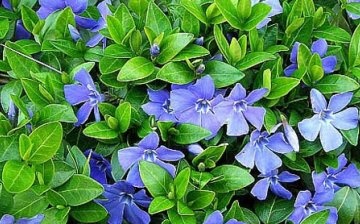Growing periwinkle in the garden and in the garden
Many people believe that periwinkle is a grave flower and consider it a bad omen to grow a periwinkle in a garden or on a backyard. However, our ancestors believed in its ability to ward off evil spirits and other misfortunes, and it was for this that they cultivated near houses. And in cemeteries it grows simply because of its unpretentiousness and vitality. Where its stems touch the ground, roots quickly form, which is why the plant quickly spreads over the accessible area, forming a carpet of leaves and flowers. For the winter, the herbaceous periwinkle sheds its leaves, but evergreen species are more common; dwarf shrubs of small periwinkle and large periwinkle.
You can plant shrubs in spring, autumn and even summer in cloudy weather. The plant loves loamy soil, and areas with diffused light. Periwinkle reproduces by seeds, dividing the bush, cuttings. By planting periwinkle near a tree, you get a beautiful ground cover that retains moisture and prevents weeds from growing. Periwinkle blooms for a long time, from May to mid-summer. During the period of active growth, in early spring, the plant can be fed with urea, and then with organic fertilizers during the budding period and at the end of summer.
To make the periwinkle thickets look neat, the ends of the stems are cut in the spring. If necessary, they can be rooted right away. It is better to pierce old sods in several places 15 centimeters deep, in spring and autumn. Growing periwinkle also requires watering in dry times. For the winter, young periwinkles need to be covered, and old plants are not afraid of frost.



